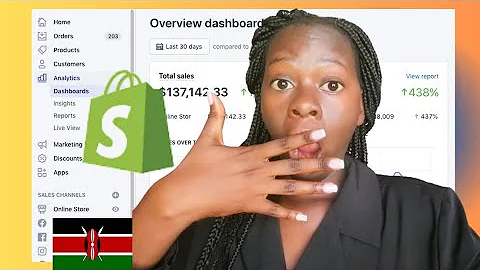Avoid These 10 Dropshipping Mistakes in 2022
Table of Contents:
- Introduction
- Mistake #1: Taking shortcuts and not spending enough time learning the dropshipping game
- Mistake #2: Not trying enough marketing platforms when testing products
- Mistake #3: Not getting custom content made for websites and advertising materials
- Mistake #4: Not thinking outside the box and following what everyone else does
- Mistake #5: Not investing in private label stores and white label stores
- Mistake #6: Selling the store at its peak time
- Mistake #7: Having poor negotiation skills
- Mistake #8: Not mastering how to pay taxes
- Mistake #9: Not taking enough risks
- Mistake #10: Neglecting mental health
Introduction
Starting a Shopify dropshipping business can be an exciting venture, but it's essential to avoid common mistakes that can hinder your success. In this article, we will discuss the top 10 mistakes to avoid when starting your Shopify dropshipping business in 2022. By understanding and addressing these mistakes, you can set yourself up for a successful and profitable dropshipping journey.
Mistake #1: Taking shortcuts and not spending enough time learning the dropshipping game
One of the most significant mistakes new entrepreneurs make is rushing into dropshipping without spending enough time learning the fundamentals. It's crucial to understand customer psychology, advertising strategies, website optimization, and customer retention techniques. By dedicating at least one to one and a half months to learning these essential aspects, you can avoid costly mistakes and increase your chances of success.
Mistake #2: Not trying enough marketing platforms when testing products
Relying solely on Facebook ads and Instagram influencers for marketing your dropshipping products can limit your reach. It's essential to explore other marketing platforms such as Google ads, TikTok ads, and YouTube ads to find your target market. By diversifying your marketing efforts, you can maximize your chances of reaching potential customers and finding the platforms that work best for your product.
Mistake #3: Not getting custom content made for websites and advertising materials
Using generic photos and videos for your advertisements and website may not resonate with your target audience. User-generated content (UGC) has proven to be more engaging and relatable to customers on social media platforms. Invest in custom content and UGC creation to create a unique brand identity and improve your ad account's performance.
Mistake #4: Not thinking outside the box and following what everyone else does
It's essential to be innovative and think outside the box when selecting products and marketing strategies. Instead of blindly following trends, find unique ways to promote your products. Consider collaborations with influencers, brand partnerships, or exploring untapped marketing channels. By taking a different approach, you can set your business apart from the competition.
Mistake #5: Not investing in private label stores and white label stores
While dropshipping is a low-risk business model, it's crucial to transition to private label or white label stores after testing a product successfully. Private labeling allows you to add your logo and branding to products, improving brand recognition and customer loyalty. By moving away from traditional dropshipping to bulk orders and third-party logistics, you can offer faster shipping times and higher-quality products.
Mistake #6: Selling the store at its peak time
One common mistake is holding onto a successful store for too long, expecting continuous growth. It's essential to recognize when your store has reached its peak performance and consider selling it while it's at its highest value. By selling at the right time, you can maximize your profits and avoid potential future declines.
Mistake #7: Having poor negotiation skills
Negotiation skills are crucial when dealing with suppliers for product pricing and collaborating with influencers for promotions. Learn how to negotiate effectively to secure better pricing and partnerships. Whether it's price matching with other suppliers or negotiating influencer fees, sharpening your negotiation skills can have a significant impact on your profit margins.
Mistake #8: Not mastering how to pay taxes
Properly managing taxes is essential for the long-term success of your dropshipping business. Consult with an accountant or tax professional to understand the tax requirements in your country or state. Utilize software solutions like TaxJar and BeProfit to ensure accurate tax calculations and streamline your tax processes.
Mistake #9: Not taking enough risks
While it's important to take calculated risks, playing it too safe can limit your business's growth potential. Explore new strategies, try different product lines, or consider bulk ordering to take your business to the next level. Embrace a mindset that embraces growth and understands that calculated risks can lead to substantial rewards.
Mistake #10: Neglecting mental health
Entrepreneurship can be mentally challenging, and it's crucial to prioritize your mental well-being. Prepare yourself for self-doubt, setbacks, and challenges that may arise throughout your journey. Take the time to focus on self-care, maintain a positive mindset, and seek support when needed. Remember, your mental health is just as important as your business's success.
Conclusion
By avoiding these top 10 mistakes when starting your Shopify dropshipping business, you can increase your chances of success in 2022. Take the time to learn the fundamentals, explore multiple marketing platforms, invest in custom content, think innovatively, and navigate the challenges of entrepreneurship. Remember to prioritize your mental health and always be willing to learn, adapt, and take calculated risks. With dedication and perseverance, you can build a thriving dropshipping business and achieve your entrepreneurial goals.
Highlights:
- Avoid shortcuts and spend time learning the dropshipping game
- Explore multiple marketing platforms to reach your target audience
- Invest in custom content and user-generated content for better engagement
- Think outside the box and find unique ways to promote your products
- Transition to private label and white label stores for increased brand value
- Consider selling your store at its peak performance
- Enhance negotiation skills for better pricing and partnerships
- Master tax management to avoid future complications
- Embrace calculated risks to fuel business growth
- Prioritize your mental health and seek support when needed
FAQ:
Q: How long should I spend learning dropshipping fundamentals before starting my business?
A: It is recommended to spend at least one to one and a half months learning the dropshipping fundamentals before launching your business.
Q: What marketing platforms should I explore besides Facebook ads and Instagram influencers?
A: Consider trying Google ads, TikTok ads, and YouTube ads to reach a wider audience and find platforms that work best for your product.
Q: Why is user-generated content important for dropshipping businesses?
A: User-generated content is more relatable and engaging to customers, increasing the chances of conversions and brand loyalty.
Q: When should I transition to private label or white label stores?
A: Once you have successfully tested a product and received 30 to 50 orders, consider moving towards private label or white label stores for branding and improved quality.
Q: How important is negotiation in dropshipping?
A: Negotiation skills are crucial for securing better pricing with suppliers and influencers, ultimately impacting your profit margins.
Q: How can I ensure proper tax management for my dropshipping business?
A: Seek advice from an accountant or tax professional and utilize software solutions like TaxJar and BeProfit to streamline tax calculations and ensure compliance.
Q: Why is taking risks important in dropshipping?
A: Calculated risks are necessary to scale your business and achieve significant growth. Playing it too safe can hinder your business's potential.
Q: How should I prioritize my mental health as a dropshipping entrepreneur?
A: Dedicate time to self-care, maintain a positive mindset, and seek support when needed. Mental well-being is crucial for long-term success and handling the challenges of entrepreneurship.



















